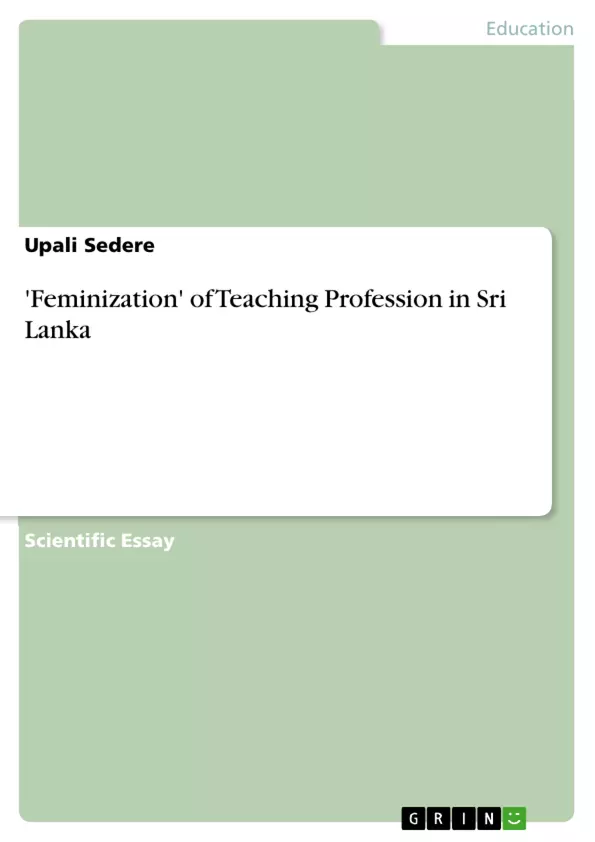Krieg (2005) in his review of impact of teacher gender on student gender states that while a large body of research focuses on the gender of students, less research explores the impacts of a teacher's gender on students (Hopf & Hatzichristou 1999 ). Evidence suggests that male teachers tend to be more authoritative whereas female teachers tend to be more supportive and expressive (Meece, 1987 ). A survey of 20 teachers indicates that male teachers are likely to select a more aggressive disciplinary approach toward boys while teachers of either gender tended to ignore boys' disruptive behavior than that of girls when the behavior was not aggressive (Rodriguez, 2002). Krieg (2005) further reveals that researchers have found that teachers interact differently with students of similar gender than they do with students of opposite gender Einarsson, C., & Granström, K. (2002 ) This includes evidence suggesting disciplinary procedures and proclivity to discipline vary by both student and teacher gender. Likewise, a teacher’s perception of student characteristics and abilities appear to systematically vary by gender. Other studies find male students benefit at the expense of female students in the amount and quality of interaction received from teachers of both genders. What has yet to be determined is how these differences in discipline, perceptions of student ability, and interactions between student and teacher influence student outcomes as measured by standardized exams.
Table of Contents
- EFFECT OF GENDER OF TEACHER ON STUDENTS:
- BACKGROUND OF THE STATUS OF WOMEN IN SRI LANKA:
- THE SYSTEM OF EDUCATION IN SRI LANKA:
- FEMINISATION OF THE TEACHING PROFESSION IN SOUTH ASIA
- Methodology:
- FEMINIZATION OF TEACHING PROFESSION IN SRI LANKA
- A. Feminization Across Sectors Of Education
- B. Differences Between Rural And Urban Areas:
- C. Differing Levels Of Gender Representation In Leadership And Management Positions:
- D. Differing Levels Between Government, Private And Community/NGO Schools:
- E. Differences Between Regions Or Low, Middle And High Income Countries:
- F. Any Correlation Between Access, Retention Or Attainment Of Students And "Feminization" Of The Teaching Profession:
- Feminization Of Teaching Is Related To Sexual And Class Divisions In Society;
- DISCUSSION
- Comparative Advantages:
- Family Friendliness in Teaching:
- Equal Opportunity and Gender Parity:
- The Real Impact of Feminazation is Not Known
Objectives and Key Themes
This monograph, an updated version of a case study submitted to UNESCO, aims to provide an in-depth analysis of the feminization of the teaching profession in Sri Lanka. It examines the trends, causes, and implications of the increasing dominance of female teachers in the country's education system.
- The impact of gender on teaching and student outcomes
- The historical and societal context of women's status in Sri Lanka
- The role of the education system in Sri Lanka in relation to gender equality
- The patterns of feminization in different sectors and levels of education
- The potential consequences and implications of feminization for the teaching profession
Chapter Summaries
The monograph begins by exploring the effect of teacher gender on students, citing research that suggests male teachers may be more authoritative while female teachers are more supportive. The chapter examines the potential influence of teacher gender on student behavior and achievement, while acknowledging the need for further research to fully understand the impact on student outcomes.
Following this, the text delves into the historical and social context of women's status in Sri Lanka. It highlights the country's early adoption of universal suffrage and its long-standing tradition of gender equality, particularly within the Buddhist religion. However, it also acknowledges the challenges women face in achieving full equality, including discriminatory family laws and ongoing issues with women's empowerment.
The monograph then focuses on the system of education in Sri Lanka, analyzing the role of the education system in promoting or hindering gender equality. This section likely examines the impact of policies, practices, and societal expectations on educational opportunities and outcomes for girls and women.
Next, the text explores the feminization of the teaching profession across South Asia, examining regional trends and potential contributing factors. This chapter aims to provide a broader context for understanding the phenomenon of feminization in Sri Lanka by comparing and contrasting it with similar trends in other South Asian nations.
The following chapter delves into the feminization of teaching in Sri Lanka itself, examining how this trend plays out across different sectors of education. This analysis likely includes comparisons between rural and urban areas, different levels of education, and the various types of schools (government, private, and community/NGO).
Keywords
Key terms and concepts explored in this monograph include: feminization of the teaching profession, gender equality, women's status, Sri Lanka, education system, teacher gender, student outcomes, societal context, family laws, South Asia, regional trends, rural and urban disparities, different levels of education, government, private, and community/NGO schools.
- Quote paper
- Dr Upali Sedere (Author), 2011, 'Feminization' of Teaching Profession in Sri Lanka, Munich, GRIN Verlag, https://www.grin.com/document/174290



